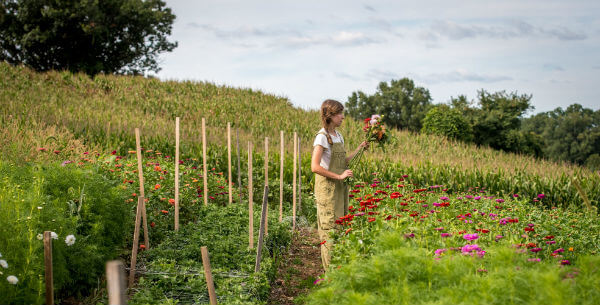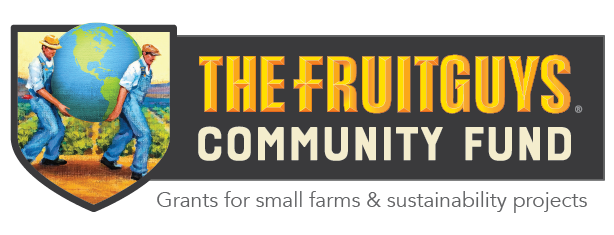
Reduced carbon footprints and record numbers of pollinators are some of this years highlights. Now 2016 farm grantees are beginning to see the benefits of their sustainability grants and all their hard work in getting their projects implemented.
The ten grantee farms chosen were awarded grants for a total of $40,188. Grantees span from California to Maryland, urban to rural, and for-profit to nonprofit. Each farm was picked by The FruitGuys Community Fund, a non-profit fiscally sponsored project of Community Initiatives, based on how well their proposed sustainability project fit into these areas of focus: pollination, soil health, water conservation, and energy efficiency, as well as increasing low-income consumers’ access to fresh produce.
2016 projects ranged from beehive installations to installing layer sling beds across the following farms: Buffalo Street Farm in Detroit, MI; Butterbee Farm in Pikesville, MD; Canvas Ranch in Ukiah, CA; Casa Rosa Farms; FARM Davis in Davis, Ca; From the Ground Up Farms in Chico, CA; Sunnyside Farm in Dover, PA; Troy Community Farm in Madison, WI; Turtle Creek Gardens in Delavan, WI; Two Boots Farm in Hampstead, MD.
Buffalo Street Farm
Buffalo Street Farm in Detroit received a grant of $5,000 to plant an orchard of mixed fruit. They used the remainder of their grant to purchase three beehives and an irrigation system.

“We have successfully implemented all aspects of our orchard project by repurposing 12 vacant lots in the neighborhood, which included the planting of 100 fruit trees and numerous native perennials, purchasing and maintaining honeybee hives, as well as the supplies necessary for upkeep and survival. The native perennials are already doing their job, as we have noticed many pollinators, including the honey bees, flying around their flowers. In the long-term, the orchard will allow us to start a fruit share with City Commons CSA, an organization which we helped found 5 years ago.
We are very happy with our proposal and how it allowed us to create the orchard we wanted! We are very excited for our trees to produce fruit and the opportunities for our business that will follow. We are also very happy to have honeybees, which not only supports our crops but helps the world’s bee population as a whole”. ~ Chris McGrane, owner & operator.
Butterbee Farm
Butterbee Farm in Pikesville, Maryland received $3,200 to help them cultivate an extra acre of land, enabling them to grow farm sales by 20%.
“Our initial goal was to transition an acre of conventionally farmed land into sustainable farming practices, growing actively on part of the acre in the first year and beginning some long-term rehabilitation with the rest. We accomplished almost all of our goals for this grant within the year. We frost seeded clover on ¾ of the acre, interseeded fescue in the spring, spread lime on the ¼ acre we planned to grow on, planted pollinators on two borders of the field, and used compost to amend some beds we grew on. The biggest challenge, which is what prevented us from spreading all of the compost and lime we wanted, was labor. But we were able to grow successfully on the ¼ acre and also put in a vigorous, healthy cover crop on the rest; we’ll finish the composting and liming next year.

The pollinating plants are still very small, but I look forward to seeing bees and butterflies all over the monarda, yarrow, and mock orange next year!” ~ Laura Beth Resnick, owner
Canvas Ranch
Canvas Ranch Farm in Petaluma, California received a $2,500 grant. With these funds, they purchased a dehuller and began telling neighboring grain growers that it was now available, while also dehulling over 500lbs of their own farro.
With the dehuller they were able to dehull over 500lbs of their own heirloom grains, offering them for sale to local restaurants and at farmers markets. They are happy that “the dehuller will be available for years for local grain growers. Encouraging the farming of more local grains.”

To help advertise this they have made the dehuller available through the North Coast Heritage Grain Alliance website, for anyone that might be interested in using it. So far three local grain growers have utilized the equipment, processing over a thousand pounds of grain.
“With the help of the grant, we purchased the dehuller in the Fall 2016 and transported it to Canvas Ranch. We alerted local grain growers that it was available to use. We dehulled over 500 lbs of our Farro. We’ll continue to get the word out into the community. Our ultimate goal is to encourage the public to buy and use heritage grains in their diets.” ~ Deborah Walton, owner.
Casa Rosa Farms
Casa Rosa Farms, from California’s central valley, was another beneficiary of a 2016 grant totaling $5,000 to purchase a forage chopper. After some initial delivery issues, they now have the machine on site at their farm, ready to be used in the coming year. Having the forage chopper will help farm create silage — plant material chopped into small pieces — for storage.

FARM Davis
FARM Davis from Davis California used their grant of $2,133 to purchase a mower as well as build and hang their own owl boxes. Funds were also used to purchase seed for cover crops to keep their orchard habitat busy over the winter months.
“This project gave us the opportunity to connect with the City of Davis Wildlife Resource Specialist who is excited about our work. I imagine that he will continue to support our project with knowledge and resources. Approximately 50 new people visited our farm because of the project. The mower will allow us to keep the fields manageable in terms of pest habitat.
At the moment we are still waiting for owls to move into the boxes. However we have been offering a workshop on owl habitats and their role in IPM. During other workshops at the farm, we were able to feature the owl box project during tours of the grounds.

We served the local Yolo and Solano County residents will the owl habitat workshop. We also served our local low income and homeless population with more food this year than any other! Approximately 300 unduplicated people were fed with FARM Davis produce, representing approximately 96 meals.” ~ Robyn Waxman, Executive Director
From the Ground Up Farms
From the Ground Up Farms were elated with their $4,855 grant. They used this funding to installed raised beds, improve irrigation, and to begin building a hoop house.

“Our successes speak for themselves. More hungry people are eating more free healthy food. The list is very long of facilities waiting for our help installing their garden too. It proves what we’re doing is working!
Our yields and quality are greatly improved after installing the raised beds while our physical labor, after installation, was greatly reduced. That’s a happy combination. Every garden installation has brought 5 more requests. These are gardens being installed and maintained by the residents of the at risk facilities. The fact that such big, long-term programs agree with our direction and want to do the same, assures us of long term sustainability. These programs are always full and always transitioning to new people.
Check out a new project called Ground Support USA. New York producer chose 9 “Do Gooders” across the entire United States. From the Ground Up and our Kentfield Gardens was one. We are featured in his new documentary. It will be a tv series and we’re honored to be in their pilot episode, so keep an eye out for it when it airs!” ~ Jenny Lowrey, Executive Director
Sunnyside Farm
In 2016 Sunnyside Farms used their $5,000 grant to test the yield and sustainability of vertical growing. This test supports their HomerHouse project, to help farmers live more economically.
“We have built our four-layer sling beds inside our constructed hoophouse. The theory we wanted to test is for wintertime growing production increases by growing vertically. We wanted cheap, easily available infrastructure to increase growing spinach.

The towers grew harvestable spinach at the same rate as the spinach grown in the beds. The same square footage, with three additional layers of growing space, increased our harvest by about 2.5 times. And the beds right next to those towers filled out and grew nicely too. So it is not too much shade produced that it stops growth in the beds.” ~ Drusilla Peters, owner
Troy Community Farm
Troy Community Farm used their $2,500 grant to add 3 new hives (and hive equipment) to their beekeeping operation. The bees are thriving, enjoying the field of clover next to the hives.
“Although the short-term outcomes were great, the long-term impacts are bigger. Honey bee hives often take a full season to build up and the second year is much more productive than the first. I expect a much greater honey yield next year. Also, going into winter this year with 7 total hives (instead of 2) all with various ages of queens, sizes of hives, amount of pollen/nectar, etc. will not only give a much better chance for coming out of winter with a sizable bee population (who can share resources), but will also be extremely educational as to what resources hives in our bee yard need to survive. These funds have given us the equipment to continue a solid beekeeping program for years to come.

The largest challenge we faced was not being able to harvest as much honey as expected. This was partly because it was the first year for most of the hives and they just spent most of their time building up population and drawing wax comb. Most of the honey harvested was all from the one overwintered hive from last year (which makes me excited for next year). I expect next year to be different!” ~ Annali Smucker-Bryan, crew leader and primary beekeeper
Turtle Creek Gardens
“We have witnessed an immediate benefit from the newly constructed swale. We no longer have large areas of pooling water when we receive excessive rainfall amounts. In our proposal for the grant and early in the spring of 2016 we evidenced that 3 to 4 inches would inundate some of our farm that we use to grow our crops. Within a week after the swale was constructed over just a couple days we received 3+ inches of rain and the swale performed perfectly. It drained the low areas and the runoff slowly coursed through our farm away from our crop land. It was very gratifying to watch this working.
With these flood prone areas now able to drain effectively, we will no longer lose the time, effort and money expended on these parts of the farm to grow our marketable crops.
We have created a feature on the farm that will cultivate beauty. There will be a functioning drainage swale that will be a habitat for all sorts of new creatures and plants that would not ordinarily be in the “middle” of a vegetable operation. We expect pollinators to thrive in the newly introduced plant species that will complement the variety of flowers that the vegetables produce.
It is obviously a multiyear project. It will take years to have the new habitat mature to its potential but we are positive for the future!” ~ Steve Tomlins, field dude
Two Boots Farm
The final 2016 grantee was Two Boots Farm, who received $5000. They used this money to build a high tunnel to maximize productivity of their tomato and cucumber crops along with ginger, turmeric and lemongrass. The tunnel provides growing space for all seasons. Funds were also used to install Mason bee and bat houses.
“We had excellent tomato and cucumber crops as predicted. We were able to yield approximately 50% more fruit from our high tunnel crops per a square foot compared to our field (unprotected) plantings.

We also grew other high-value crops in the tunnel that cannot be grown outside in our region. We grew ginger and turmeric, which we are still selling. With our current numbers, we were able to gross $16 per a square foot from our high tunnel space in a season. This number is on the high end of what’s possible considering spinach and turmeric are two of the highest value crops we grow but this gives a great example of the income potential of the high tunnel and gives us targets for growth beyond this project funding cycle.
We are thrilled with the outcome of this project. Our gross sales for the season (which is still not finished and income in still coming in) has far exceeded our income expectations for the year. This is largely due to having this high tunnel. We had projected a 39% total gross income growth from 2015 – 2016 but instead our gross income from 2015 – 2016 is 62.7% (this number will actually be higher since we plan to continue selling through the end of the year.) This puts us well on our way to financial sustainability.” ~ Elsa Lane, owner
Now that our 2016 grants have wrapped up for the season, we’re in the process of receiving and evaluating 2017’s grant requests. Interested in helping out or donating to our small farm sustainability projects? Your time and money goes towards growing healthy produce across the U.S.




